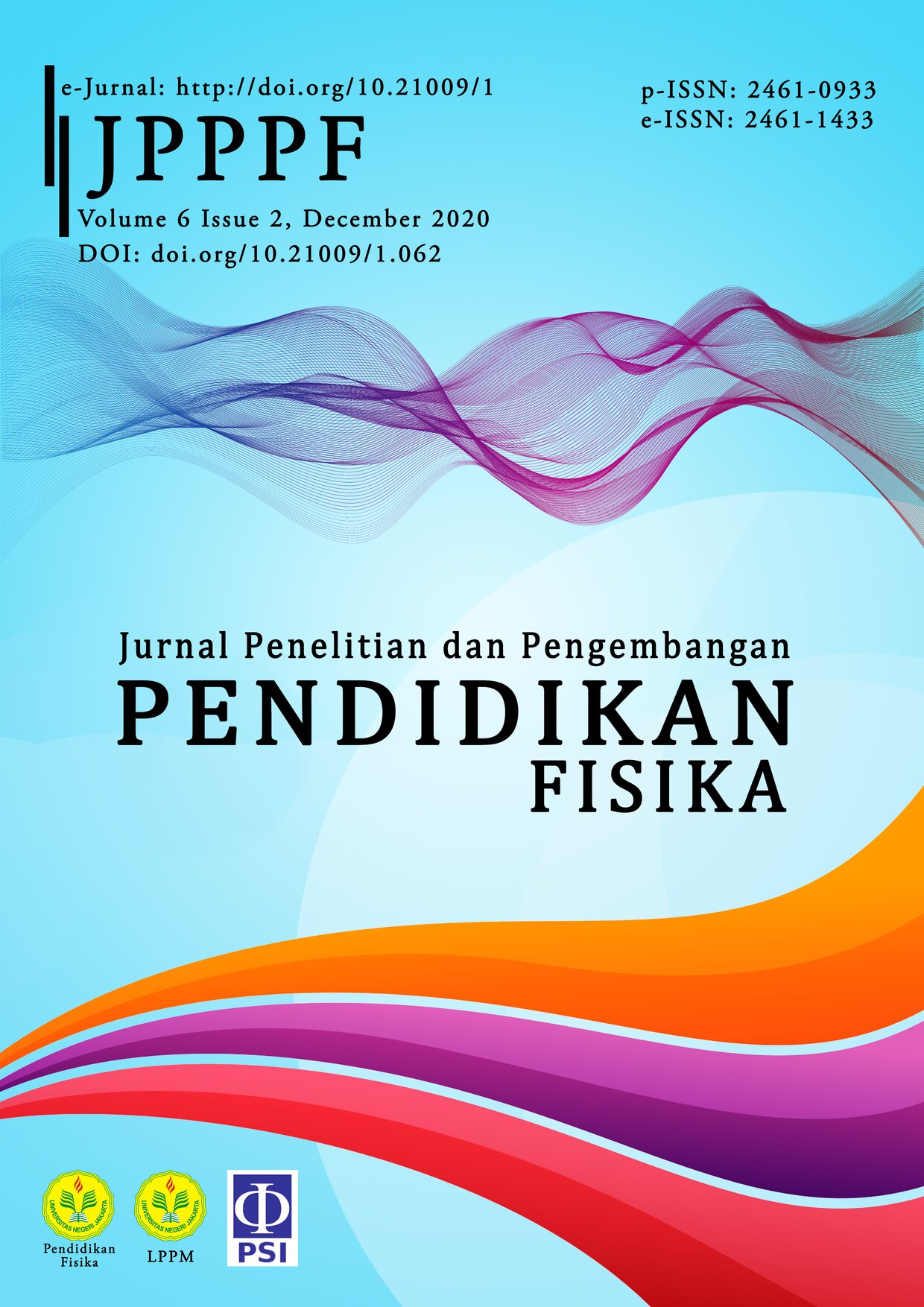The 3D Printing in Material Research and Medical Physics Education and Its Accuracy Study
DOI:
https://doi.org/10.21009/1.06209Keywords:
3D printing, physics education, medical physics, accuracy studyAbstract
This study aims to construct prototypes using three-dimensional (3D) printing technology as a research apparatus and a physics education instrument, particularly in medical physics education. Two main designs of prototypes have been arranged. Two foam NaCl templates are drawn using computer-aided design (CAD) software. Image processing techniques achieve a 3D model of a thoracic vertebra. All 3D model data are printed using polylactic acid (PLA) filament. The prints of foam NaCl templates are utilized for holding the NaCl powder. The prototype of a human vertebra is used for visualization of the real condition of the human bone anatomy. The results of the prototypes are analyzed to investigate the similarity between the model and the prints. This investigation is done using a Vernier Caliper and CT Scan. The measurement using Caliper shows a higher percentage in likeness than the CT-Scan. All the accuracy study shows they have more than 83% in similarity. It can be concluded that all built prototypes have prominent exactitude and can support the material research using the printed NaCl templates. Hereafter, a bone mock-up’s genuine perception can function for further application, such as implant or surgery planning.
References
Asmaria, T, Annur, D, Utomo, M, Sari, A, Malau, D, Prabowo Y, Rahyussalim, AM, Amal 2019, ‘Validation of 3D models using template matching for implant planning’, in 2019 16th International Conference on Quality in Research, QIR 2019 - International Symposium on Electrical and Computer Engineering, IEEE, pp. 1-4.
Asmaria, T, Sajuti, D, Ain, K 2020, ‘3D printed PLA of gallbladder for virtual surgery planning’, in 3D printed PLA of gallbladder for virtual surgery planning, AIP Publishing, p. 050005.
Brouwers, L, Teutelink, A, Tilborg, V, Jongh, M, Lansin, K, Bemelman, M 2018, ‘Validation study of 3D-printed anatomical models using 2 PLA printers for preoperative planning in trauma surgery, a human cadaver study’, European Journal of Trauma and Emergency Surgery, Springer Berlin Heidelberg, vol. 45, pp. 1013-020.
Choi, J, Choi, J, Kim, N, Kim, Y, Lee, J, Kim, M, Lee, J, Kim, M 2002, ‘Analysis of errors in medical rapid prototyping models’, International Journal of Oral and Maxillofacial Surgery, vol. 31, no. 1, pp. 23–32.
Ciobotaru, V, Combes, N, & Ternacle, J 2018, ‘The value of 3D printed models for device sizing in percutaneous left atrial appendage occlusion’, Archives of Cardiovascular Diseases Supplements, Elsevier Masson SAS, vol. 10, no. 1, pp. 57-8.
Dietrich, C, Ender, A, Baumgartner, S, Mehl A 2017, ‘A validation study of reconstructed rapid prototyping models produced by two technologies’, Angle Orthodontist, vol. 87, no. 5, pp. 782-87.
Dizon, JRC, Espera, AH, Chen, Q, Advincula, RC 2018, ‘Mechanical characterization of 3D-printed polymers’, Additive Manufacturing, Elsevier BV, vol. 20, pp. 44-67.
Fonda, C 2013, ‘A Practical Guide to Your First 3D Print, Low-Cost 3D Printing for Science, Education and Sustainable Development’, viewed 31 Juli 2020, http://sdu.ictp.it/3D/.
Gharini, PPR, Herianto, H, Arfian, N, Satria, FB, Amin, N 2018, ‘3 Dimensional Printing in Cardiology: Innovation for Modern Education and Clinical Implementation’, ACI (Acta Cardiologia Indonesiana), vol. 4, no. 2, p. 103.
Gokhare, VG, Raut, DN & Shinde, DK 2017, ‘A Review paper on 3D-Printing Aspects and Various Processes Used in the 3D-Printing’, International Journal of Engineering Research & Technology (IJERT), vol. 6, no. 6, pp. 953-58.
Kuswanto, D, Iftira, NJ & Hapinesa, OM 2018, ‘3D Printing for Fashion Development’, Proceedings - 2018 4th International Conference on Science and Technology, ICST 2018, IEEE, pp. 1-6.
Lynn, R, Saldana, C, Kurfess, T, Reddy, N, Simpson, T, Jablokow, K, Tucker, T, Tedia, S, Williams, C 2016, ‘Toward Rapid Manufacturability Analysis Tools for Engineering Design Education’, Procedia Manufacturing, vol. 5, pp. 1183-196.
Manmadhachary, A, Ravi Kumar, Y & Krishnanand, L 2016, ‘Improve the accuracy, surface smoothing and material adaption in STL file for RP medical models’, Journal of Manufacturing Processes, The Society of Manufacturing Engineers, vol. 21, pp. 46-55.
Mikolajczyk, T, Latos, H, Paczkowski, T, Pimenov, DY, Szynka, T 2018, ‘Using CAD CAM system for manufacturing of innovative cutting tool’, Procedia Manufacturing, Elsevier BV, vol. 22, pp. 160-65.
Milde, J, Morovič, L & Blaha, J 2017, ‘Influence of the layer thickness in the Fused Deposition Modeling process on the dimensional and shape accuracy of the upper teeth model’, MATEC Web of Conferences, p. 137.
Ngo, D, Kashani, A, Imbalzano, G, Nguyen, KTQ, Hui, D 2018, ‘Additive manufacturing (3D printing): A review of materials, methods, applications and challenges’, Composites Part B: Engineering, Elsevier, vol. 143, pp. 172-96.
Oktasari, D, Kuswanto, H, Ismet, I, & MS, S 2018, ‘The Technology Pedagogy Knowledge (TPK) Teacher Using Worksheet 3D Pageflip Professional for Promoting Argumentation Skills’ High-Schools Students in Physics Learning’, Jurnal Penelitian & Pengembangan Pendidikan Fisika, vol. 4, no. 2, pp. 131-40.
Popescu, AT, Stan, O & Miclea, L 2014, ‘3D printing bone models extracted from medical imaging data’, Proceedings of 2014 IEEE International Conference on Automation, Quality and Testing, Robotics, pp. 1-5.
Prša, J 2018, ‘Concepts for X-ray Based 3D Replication in Rapid Prototyping Environment’, Technische Universität München.
Putz, F, Scherer S, Ober, M, Morak, R, Paris, O, Hüsing, N 2018, ‘3D Printing of Hierarchical Porous Silica and α-Quartz’, Advanced Materials Technologies, vol. 3 no. 7, pp. 3-7.
Rochman, DD & Anwar, A 2020, ‘Make or Buy: Case Study of 3D Printing Spare Parts Adoption’, International Journal of Psychosocial Rehabilitation, vol. 24, no. 2, pp. 2940-945.
Savini, A & Savini, G 2015, ‘A short history of 3D printing, a technological revolution just started’, Proceedings of the 2015 ICOHTEC/IEEE International History of High-Technologies and their Socio-Cultural Contexts Conference, HISTELCON, pp. 1-8.
Wibowo, A, Vyas, C, Cooper, G, Qulub, F, Suratman, R, Mahyuddin, AI, Dirgantara, T, Bartolo, P 2020, ‘3D printing of polycaprolactone-polyaniline electroactive Scaffolds for bone tissue engineering’, Materials, vol. 13, no. 3, pp. 1-17.











